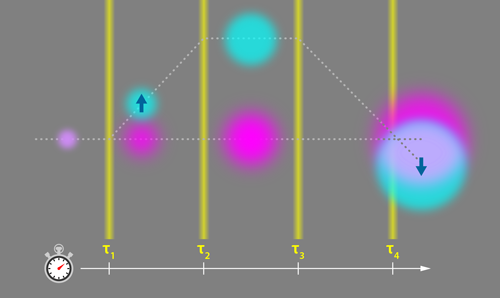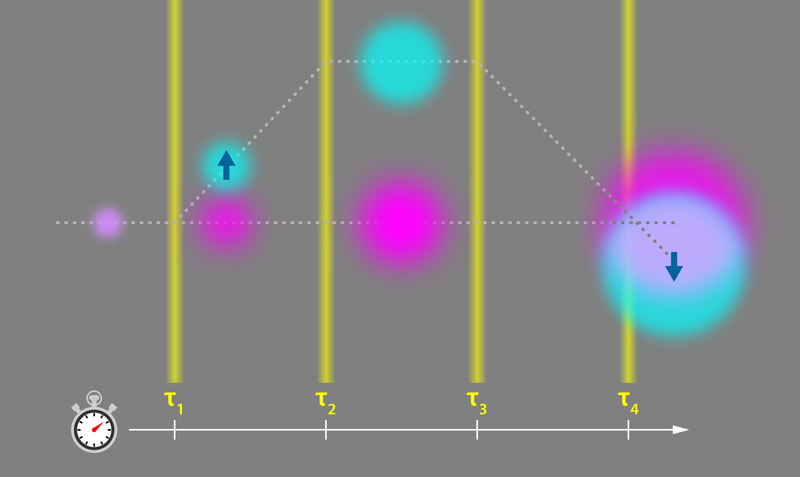Interferometer for Lighter Atoms
An atom interferometer uses laser pulses to first split apart a collection of atoms and then recombine them to reveal a wave-like interference pattern. Usually, this pattern is only visible when the atoms are cooled to a few millionths of a degree above absolute zero, but now a team of researchers working with lithium atoms has done it at somewhat higher temperatures. This lithium interferometer could be used to measure the fine structure constant—a key fundamental constant of electromagnetism—with a precision that could eventually be competitive with other techniques.
Many research groups around the world are developing atom interferometers to precisely measure gravity and inertia, as well as fundamental constants. The fine structure constant, for example, can be determined by precisely measuring the amount of kick, or recoil, that atoms receive when hit with a laser pulse inside an interferometer. These sorts of experiments typically use relatively heavy atoms, like cesium or rubidium, but a bigger kick—and therefore a bigger signal—could be had with lighter atoms. “We asked ourselves what is the lightest atom we could practically use,” says Holger Müller of the University of California, Berkeley. The answer was lithium, as it is both low in mass and controllable with existing laser technology.
To make a high-precision lithium interferometer, one would typically need to cool the atoms to below 1 microkelvin ( K), so that their average thermal motion would be less than the kick in velocity they receive from laser pulses. To reach this low temperature, however, “hot” atoms would be removed, enough to weaken the interference signal. To keep more atoms, Müller’s team developed an interferometer that required less cooling.
The team’s setup traps around a million lithium atoms and cools them to 300 K. For each interference run, they shut off the trap and expose the atoms to a sequence of four laser pulses. The first pulse gives an upward kick to a fraction of the atoms (call them “moving” atoms) while leaving the rest alone (“static” atoms). This “beam-splitting” pulse is followed by two pulses that act like mirrors, directing a portion of the moving atoms back down toward the static ones. The fourth pulse recombines the two groups, causing them to interfere. In principle, this interference should be visible as an oscillation in the number of moving atoms as one varies the time between laser pulses—which is equivalent to lengthening one arm of a traditional optical interferometer. However, two complications stand in the way of measuring this signal.
The first complication stems from the average thermal motion being 10 times larger than the expected recoil velocity from laser kicks. As a result, the two atom populations inflate in size (like expanding clouds) faster than their centers of mass can separate. To overcome this spatial overlapping, the team took advantage of the fact that static and moving atoms are in two different electronic ground states. The researchers could therefore use a laser “flash” at a specific frequency to take a picture of just moving atoms.
The second complication involves an effect of the two mirror pulses. Each of these pulses scatters some atoms into trajectories that end up colliding to form a second interference pattern at a location slightly removed from the main pattern. This extra interference pattern would normally blur out the first one. To disentangle them, the team tuned their system to produce a combined “beat” signal—akin to the slow wobbling oscillations one gets when two musical pitches at nearly the same frequency are played simultaneously. By measuring this beating pattern, they were able to determine the recoil velocity with a level of sensitivity roughly 10 times less than state-of-the-art interferometers, says Berkeley team member Kayleigh Cassella. The team is already working on boosting sensitivity.
The new detection scheme is original in that it allows the recoil signal to be detected, even with two nearly overlapping interference patterns, says metrology expert Saïda Guellati-Khelifa from the Kastler-Brossel Laboratory in Paris. But she’s not convinced that the technique will be able to surpass interferometry with cold, heavy atoms.
Grant Biedermann of Sandia National Laboratories in Albuquerque, New Mexico, is more optimistic, although he is aware of the technical challenges that lie ahead. “It’s exciting to consider precision measurement with light atoms, such as lithium, that are more challenging to cool,” he says. He’s also intrigued by the team’s speculation that the technique might work with electrons, whose much larger recoil might make them sensitive to relativistic effects such as length contraction.
This research is published in Physical Review Letters.
–Michael Schirber
Michael Schirber is a Corresponding Editor for Physics Magazine based in Lyon, France.





